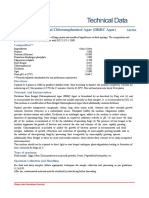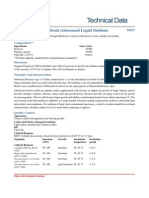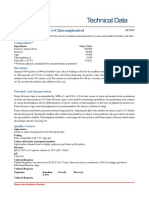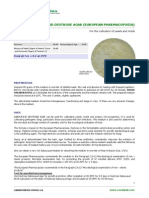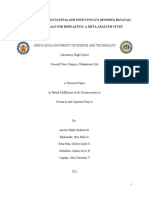MH096
MH096
Uploaded by
Rocío CPérezCopyright:
Available Formats
MH096
MH096
Uploaded by
Rocío CPérezOriginal Description:
Copyright
Available Formats
Share this document
Did you find this document useful?
Is this content inappropriate?
Copyright:
Available Formats
MH096
MH096
Uploaded by
Rocío CPérezCopyright:
Available Formats
Technical Data
Potato Dextrose Agar MH096
Intended use
Recommended for the cultivation of yeasts and moulds from pharmaceutical products in accordance with the microbial
limit testing by harmonized methodology of USP/EP/BP/JP/IP.
Composition**
Ingredients Gms / Litre
Infusion from potatoes 200.000
Dextrose (Glucose) 20.000
Agar 15.000
pH after sterilization ( at 25°C) 5.6±0.2
**Formula adjusted, standardized to suit performance parameters
Directions
Suspend 39.0 grams in 1000 ml purified/distilled water. Heat to boiling to dissolve the medium completely. Sterilize
by autoclaving at 15 lbs pressure (121°C) for 15 minutes or as per validated cycle. Cool to 45-50°C. Mix well and pour into
sterile Petri plates or tubes as desired. In specific work, when pH 3.5 is required, acidify the medium with sterile 10% tartaric
acid. The amount of acid required for 100 ml of sterile, cooled medium is approximately 1 ml. Do not heat the medium after
addition of the acid.
Principle And Interpretation
Yeast and moulds constitute a large and divergent group of microorganisms consisting of several thousands species. Yeast
and moulds can cause various degrees of food decomposition. Invasion and growth may occur on virtually any type of food
if environmental conditions are not limiting. Some foodborne yeasts and moulds are undesirable because of potential hazards
to human and animal health (1).
Potato Dextrose Agar, prepared in accordance with the harmonized methodology of USP/EP/BP/JP/IP (2,3,4,5,6) is
recommended for microbial limit tests in pharmaceutical testing. It is also used for stimulating sporulation, for maintaining
stock cultures of certain dermatophytes and for differentiation of typical varieties of dermatophytes on the basis of pigment
production (7).
Potato infusion and dextrose (glucose) promote luxuriant fungal growth. Adjusting the pH of the medium by tartaric acid to 3.5
inhibits the bacterial growth. Heating the medium after acidification should be avoided as it may hydrolyse the agar,
which can render the agar unable to solidify.
Type of specimen
Pharmaceutical samples
Specimen Collection and Handling
For pharmaceutical samples, follow appropriate techniques for sample collection, processing as per pharmaceutical guidelines
(2,3,4,5,6).
After use, contaminated materials must be sterilized by autoclaving before discarding.
Warning and Precautions
Read the label before opening the container. Wear protective gloves/protective clothing/eye protection/face protection.
Follow good microbiological lab practices while handling specimens and culture. Standard guidelines should be
followed while handling specimens. Safety guidelines may be referred in individual safety data sheets.
Limitations
1. For heavily contaminated samples, the media must be supplemented with inhibitory agents for inhibiting bacterial growth
with lower pH.
2. Some pathogenic fungi may produce infective spores which are easily dispersed in air, so examination should be carried out
in safety cabinet.
3. Further biochemical tests should be carried out for confirmation.
Performance and Evaluation
Performance of the medium is expected when used as per the direction on the label within the expiry period when
stored at recommended temperature.
Please refer disclaimer Overleaf.
HiMedia Laboratories Technical Data
Quality Control
Appearance
Cream to yellow homogeneous free flowing powder
Gelling
Firm, comparable with 1.5% Agar gel
Colour and Clarity of prepared medium
Yellow coloured clear to slightly opalescent gel forms in Petri plates
Reaction
pH of 3.9% w/v aqueous solution at 25°C (after sterilization).
pH
5.40-5.80
Growth Promotion Test
Growth Promotion was carried out in accordance with the harmonized method of USP/EP/BP/JP/IP, and growth was
observed at 20-25°C for specified time. Recovery rate is considered as 100% for fungus growth on Sabouraud Dextrose
Agar
Growth Promoting Properties
Growth of microorganism comparable to that previously obtained with previously tested and approved lot of medium
occurs at the specified temperature for not more than the shortest period of time specified inoculating <= 100 cfu
Cultural Response
Cultural characteristics observed after incubation at 20-25 °C for 2-5 days. Recovery rate is considered as 100% for fungus
growth on Sabouraud Dextrose Agar.
Organism Inoculum Growth Observed Lot Recovery Incubation Incubation
(CFU) value (CFU) temperature period
Test strain preparation
# Aspergillus brasiliensis 50 -100 luxuriant 25 -100 >=50 % 20 -25 °C 5 -7 Day
ATCC 16404 (00053*)
Additional Microbiological
Testing
Aspergillus fumigatus 50 -100 luxuriant 25 -100 >=50 % 20 -25 °C 5 -7 Day
ATCC 9197
Candida albicans 50 -100 luxuriant 35 -100 >=70 % 20 -25 °C 2 -3 Day
ATCC 10231 (00054*)
Saccharomyces cerevisiae 50 -100 luxuriant 35 -100 >=70 % 20 -25 °C 2 -5 Day
ATCC 9763 (00058*)
Rhodotorula mucilaginosa luxuriant 20 -25 °C 3 -5 Day
DSM 70403
Geotrichum candidum good- luxuriant 25 -30 °C 3 -5 Day
DSM 1240
Penicillium communae fair -good 25 -30 °C 3 -5 Day
ATCC 10248
Trichophyton ajelloi fair-good 25 -30 °C 3 -7 Day
ATCC 28454
Key : (#) - Formerly known as Aspergillus niger, (*) - corresponding WDCM numbers
Storage and Shelf Life
Store between 10-30°C in a tightly closed container and the prepared medium at 20-30°C. Use before expiry date on
the label. On opening, product should be properly stored dry, after tightly capping the bottle in order to prevent lump
formation due to the hygroscopic nature of the product. Improper storage of the product may lead to lump formation.
Store in dry ventilated area protected from extremes of temperature and sources of ignition Seal the container tightly after
use. Product performance is best if used within stated expiry period.
Disposal
User must ensure safe disposal by autoclaving and/or incineration of used or unusable preparations of this product. Follow
established laboratory procedures in disposing of infectious materials and material that comes into contact with sample must
be decontaminated and disposed of in accordance with current laboratory techniques (8,9).
Please refer disclaimer Overleaf.
HiMedia Laboratories Technical Data
Reference
1. Salfinger Y., and Tortorello M.L. , 2015, Compendium of Methods for the Microbiological Examination of Foods, 5th Ed.,
American Public Health Association, Washington, D.C.
2. The United States Pharmacopoeia-National Formulatory (USP-NF), 2022.
3. European Pharmacopoeia, 2022, 10 th volume, European Directorate for the quality of medicines & Healthcare.
4. The British Pharmacopoeia, 2022, Medicines and Healthcare products Regulatory Agency.
5. The Japanese Pharmacopoeia, 17th edition, 2016, The Ministry of Health, Labour and welfare.
6. Indian Pharmacopoeia, 2022, Indian Pharmacopoeia Commission, Ministry of Health and Family Welfare Government of
India.
7. MacFaddin J., 1985, Media for the Isolation-Cultivation-Identification-Maintenance of Medical Bacteria, Vol.1, Williams
and Wilkins, Baltimore
8. Isenberg, H.D. Clinical Microbiology Procedures Handbook. 2nd Edition.
9. Jorgensen, J.H., Pfaller, M.A., Carroll, K.C., Funke, G., Landry, M.L., Richter, S.S and Warnock., D.W. (2015)
Manual of Clinical Microbiology, 11th Edition. Vol. 1.
Revision : 06/2023
Disclaimer :
User must ensure suitability of the product(s) in their application prior to use. Products conform solely to the information contained in this and
other related HiMedia™ publications. The information contained in this publication is based on our research and development work and is to the best
of our knowledge true and accurate. HiMedia™ Laboratories Pvt Ltd reserves the right to make changes to specifications and information related
to the products at any time. Products are not intended for human or animal or therapeutic use but for laboratory,diagnostic, research or further
manufacturing use only, unless otherwise specified. Statements contained herein should not be considered as a warranty of any kind, expressed or
implied, and no liability is accepted for infringement of any patents.
HiMedia Laboratories Pvt. Ltd. Corporate Office : Plot No.C-40, Road No.21Y, MIDC, Wagle Industrial Area, Thane (W) - 400604, India.
Customer care No.: 022-6147 1919 Email: techhelp@himedialabs.com Website: www.himedialabs.com
You might also like
- Pharmaceutical Microbiology: A Laboratory ManualFrom EverandPharmaceutical Microbiology: A Laboratory ManualRating: 3.5 out of 5 stars3.5/5 (3)
- Clinical PharmacyDocument38 pagesClinical PharmacyBalakrishna Thalamanchi100% (2)
- STEARNS - Encyclopedia of European Social History (From 1350 To 2000) PDFDocument2,988 pagesSTEARNS - Encyclopedia of European Social History (From 1350 To 2000) PDFPopescuAnamariaNo ratings yet
- MH144 SJSMSNDocument3 pagesMH144 SJSMSNsulistyani sapardiNo ratings yet
- GMH290Document3 pagesGMH290CarolinaYepesBarcinillaNo ratings yet
- Sabouraud Dextrose Broth (Sabouraud Liquid Medium) : Intended UseDocument3 pagesSabouraud Dextrose Broth (Sabouraud Liquid Medium) : Intended UseCintya Arum SariNo ratings yet
- Technical Data: Plate Count Agar (Standard Methods Agar)Document2 pagesTechnical Data: Plate Count Agar (Standard Methods Agar)பொ.தெய்வராஜன்No ratings yet
- MH581Document3 pagesMH581Abid Iqbal ARDNo ratings yet
- Plate Count Agar (Standard Methods Agar) : Intended UseDocument3 pagesPlate Count Agar (Standard Methods Agar) : Intended UsenuraenirianNo ratings yet
- Pseudomonas Agar (For Pyocyanin) (In A Accordance With IP 2007)Document2 pagesPseudomonas Agar (For Pyocyanin) (In A Accordance With IP 2007)sezinaltiokkNo ratings yet
- Corn Meal Agar: Intended UseDocument2 pagesCorn Meal Agar: Intended Usealbdanyghmdan609No ratings yet
- Sabouraud Cycloheximide Chloramphenicol Agar: Intended UseDocument3 pagesSabouraud Cycloheximide Chloramphenicol Agar: Intended UsenadyasantikaNo ratings yet
- TDS MH443Document3 pagesTDS MH443florengrace.fg98No ratings yet
- MP5332Document3 pagesMP5332satyen.ghosh1111No ratings yet
- Chloran Rose Bengal Chloramphenicol Agar (DRBC Agar) : Intended UseDocument3 pagesChloran Rose Bengal Chloramphenicol Agar (DRBC Agar) : Intended Useபொ.தெய்வராஜன்No ratings yet
- Tryptic Soya Agar: Intended UseDocument2 pagesTryptic Soya Agar: Intended UseGopi NathNo ratings yet
- RM007Document3 pagesRM007Gopi NathNo ratings yet
- Malt Extract Agar: Intended UseDocument3 pagesMalt Extract Agar: Intended UseMimma MonicaNo ratings yet
- M121IDocument2 pagesM121IventyfaniaNo ratings yet
- M001 PDFDocument3 pagesM001 PDFkeresahanmuNo ratings yet
- Himedia M933Document3 pagesHimedia M933linaNo ratings yet
- TechnicalDocument2 pagesTechnicalnafiw31466No ratings yet
- Nutrient Agar 2Document3 pagesNutrient Agar 2Khaza VinodNo ratings yet
- MM242Document3 pagesMM242Anand H SNo ratings yet
- Potato Dextrose Agar HIMEDIA PDFDocument3 pagesPotato Dextrose Agar HIMEDIA PDFNananci MartinezNo ratings yet
- BETA-SSA Agar (Group A Streptococci Selective Agar)Document3 pagesBETA-SSA Agar (Group A Streptococci Selective Agar)uttam.micro404No ratings yet
- RM001Document3 pagesRM001AbdulrahmanNo ratings yet
- Inserto HimediaDocument3 pagesInserto HimediayyewelsNo ratings yet
- M1297ADocument3 pagesM1297Ateena jacobNo ratings yet
- CR014Document3 pagesCR014Nabila Putri SabilaNo ratings yet
- Clostridial Agar: Intended UseDocument3 pagesClostridial Agar: Intended Usesg.comNo ratings yet
- MU004 - Antibiotic Assay Medium 11Document2 pagesMU004 - Antibiotic Assay Medium 11florengrace.fg98No ratings yet
- Buffered Peptone Water, GranulatedDocument3 pagesBuffered Peptone Water, GranulateduttamNo ratings yet
- M-BCG Yeast and Mould Broth, Modified: Intended UseDocument3 pagesM-BCG Yeast and Mould Broth, Modified: Intended UseWilliamNo ratings yet
- Urea Broth Base (Diagnostic Stuarts Urea Broth Base) : Intended UseDocument3 pagesUrea Broth Base (Diagnostic Stuarts Urea Broth Base) : Intended Use10605114No ratings yet
- Technical Data: Peptone WaterDocument3 pagesTechnical Data: Peptone WaterAbdulrahmanNo ratings yet
- Potato Dextrose Agar With 3% Agar: CompositionDocument2 pagesPotato Dextrose Agar With 3% Agar: CompositionAnugrah Pratap singhNo ratings yet
- M008SDocument3 pagesM008Sanulorance98No ratings yet
- Sabouraud Dextrose BrothDocument2 pagesSabouraud Dextrose Brothuttam.micro404No ratings yet
- Buffered Peptone Water: Intended UseDocument3 pagesBuffered Peptone Water: Intended UseUlliaNo ratings yet
- Acetate Agar: Intended UseDocument2 pagesAcetate Agar: Intended UseMIcro LabNo ratings yet
- Peptone Water: Intended Use: CompositionDocument3 pagesPeptone Water: Intended Use: Composition10605114No ratings yet
- Sabouraud Dextrose BrothDocument2 pagesSabouraud Dextrose Brothrdn2111No ratings yet
- BHI BrothDocument3 pagesBHI BrothHà Anh Minh LêNo ratings yet
- M403 PDFDocument2 pagesM403 PDFSmyle KatariaNo ratings yet
- Potato Dextrose Agar: CompositionDocument2 pagesPotato Dextrose Agar: CompositionNalita Aurelia AuritaNo ratings yet
- Hicrome™ Ecc Selective Agar Base: Intended Use: CompositionDocument3 pagesHicrome™ Ecc Selective Agar Base: Intended Use: Compositionafiifa1015No ratings yet
- Blood Agar Base (Infusion Agar) : Intended UseDocument3 pagesBlood Agar Base (Infusion Agar) : Intended UseJohnree A. EvangelistaNo ratings yet
- Broth: Intended UseDocument3 pagesBroth: Intended UseRaga PreethikaNo ratings yet
- MB PDFDocument3 pagesMB PDFARATHY M NAIR 2147718No ratings yet
- Conda Lab Dextrose Sabouraud 1024 - en - 3Document2 pagesConda Lab Dextrose Sabouraud 1024 - en - 3Natália DiasNo ratings yet
- Potato Dextrose Agar EP/USP/BAM: Industry RegulationsDocument2 pagesPotato Dextrose Agar EP/USP/BAM: Industry RegulationsDylan UnrauNo ratings yet
- Gifu Anaerobic Broth (GAM) : Intended UseDocument3 pagesGifu Anaerobic Broth (GAM) : Intended UseVishwanath Unique BiotechNo ratings yet
- Malt Extract Agar Base: Intended UseDocument2 pagesMalt Extract Agar Base: Intended UseGopi NathNo ratings yet
- Stuart Transport Medium (Transport Medium, Stuart) : Intended UseDocument3 pagesStuart Transport Medium (Transport Medium, Stuart) : Intended Useradiny audiaNo ratings yet
- PDA With ChlorampenicolDocument2 pagesPDA With ChlorampenicolIrene Ratri Andia SasmitaNo ratings yet
- Diluting Fluid A: Intended UseDocument2 pagesDiluting Fluid A: Intended UseCarina Munir SayidiNo ratings yet
- Sabouraud Dextrose Agar (European Pharmacopoeia) : CAT Nº: 1024Document0 pagesSabouraud Dextrose Agar (European Pharmacopoeia) : CAT Nº: 1024Fred GreenNo ratings yet
- Tn1345en MKDocument2 pagesTn1345en MKivanNo ratings yet
- Sabouraud-4 % Dextrose Agar Acc. Harm. EP/USP/JP: Ordering Number: 1.05438.0500 / 1.05438.5000Document3 pagesSabouraud-4 % Dextrose Agar Acc. Harm. EP/USP/JP: Ordering Number: 1.05438.0500 / 1.05438.5000rosalia destikaNo ratings yet
- MH118Document4 pagesMH118Nanthicha KrajangpawNo ratings yet
- Sabouraud Dextrose Broth (Sabouraud Liquid Medium) : CompositionDocument2 pagesSabouraud Dextrose Broth (Sabouraud Liquid Medium) : CompositionTofik HidayatNo ratings yet
- Evidence For EvolutionDocument12 pagesEvidence For Evolutionapi-259727482100% (2)
- Fire Must Be Kept BurningDocument6 pagesFire Must Be Kept BurningAGNESNo ratings yet
- ss4 Instructions PDFDocument7 pagesss4 Instructions PDFIanDubhNo ratings yet
- Capstone and Research ProjectDocument86 pagesCapstone and Research ProjectJelly AceNo ratings yet
- Diagnose Rice CookerDocument13 pagesDiagnose Rice CookerPeter Anunsawon PapasinNo ratings yet
- Laxatives & Antidiarrheals UseDocument19 pagesLaxatives & Antidiarrheals UseDhurjati MajumdarNo ratings yet
- 2018 Region Iv - 5A and 6A Track & Field Meet Alamo Stadium: Bus, Team, Workers ParkingDocument1 page2018 Region Iv - 5A and 6A Track & Field Meet Alamo Stadium: Bus, Team, Workers ParkingWilliam GrundyNo ratings yet
- Introd of Fall Protection - Oil and Gas - Capital SafetyDocument71 pagesIntrod of Fall Protection - Oil and Gas - Capital SafetyGustavo Carnevali MendesNo ratings yet
- 2018 05 Pressure Equipment Design ExaminationsDocument2 pages2018 05 Pressure Equipment Design ExaminationsEduardo PiattiNo ratings yet
- Mishra Sir Project ReportDocument51 pagesMishra Sir Project Reportthisismeamit20103094No ratings yet
- Qualitative AnalysisDocument3 pagesQualitative AnalysisYukeling TayNo ratings yet
- FM Global Property Loss Prevention Data Sheets: 1.0 SCOPEDocument30 pagesFM Global Property Loss Prevention Data Sheets: 1.0 SCOPEDaterNo ratings yet
- Fall Dateline 2007Document24 pagesFall Dateline 2007indydentalsocietyNo ratings yet
- FH GP Kuehlcontainer enDocument16 pagesFH GP Kuehlcontainer ennguyen van hauNo ratings yet
- History of Qi (Chi) CultivationDocument4 pagesHistory of Qi (Chi) CultivationValeria Peñaranda ValdaNo ratings yet
- Application For The Best Junior Commissioned Police OfficerDocument37 pagesApplication For The Best Junior Commissioned Police OfficerChristelle de los CientosNo ratings yet
- Rate Chart PanchakarmaDocument2 pagesRate Chart PanchakarmayogasanaNo ratings yet
- Welfare Facilties Under Factories Act, 1948 and Maharashtra Factory Rules, 1963Document20 pagesWelfare Facilties Under Factories Act, 1948 and Maharashtra Factory Rules, 1963vaibhavrd83% (6)
- Cvs ExaminationDocument1 pageCvs ExaminationAnn SyaNo ratings yet
- Ethiopia Consolidated ART Guideline 2014Document165 pagesEthiopia Consolidated ART Guideline 2014TayeNo ratings yet
- Product Manual 02035 (Revision B) : Load Sharing ModuleDocument36 pagesProduct Manual 02035 (Revision B) : Load Sharing Moduleincore1976No ratings yet
- Shopping in Our LifeDocument4 pagesShopping in Our LifeViktória IvànNo ratings yet
- Determinacion de Acidos GrasosDocument24 pagesDeterminacion de Acidos GrasosJefferson Roy Mego EnriquezNo ratings yet
- 2307 Jan 2018 ENCS v3 BIRDocument2 pages2307 Jan 2018 ENCS v3 BIRlnbsanclementeNo ratings yet
- Form 5 Chemistry: Chemical For ConsumerDocument16 pagesForm 5 Chemistry: Chemical For Consumernaqiu96No ratings yet
- A Case Study of Risk Factors For Lymphatic Filariasis in The Republic of CongoDocument12 pagesA Case Study of Risk Factors For Lymphatic Filariasis in The Republic of CongowindwalkersNo ratings yet
- Masterflow 880: Cementitious High Strength, Non-Shrink, Iron Reinforced Precision GroutDocument2 pagesMasterflow 880: Cementitious High Strength, Non-Shrink, Iron Reinforced Precision GroutMu FaddaNo ratings yet
- Activity 03 Name: - ID No.: - Score: - Rating: - Problem 01Document3 pagesActivity 03 Name: - ID No.: - Score: - Rating: - Problem 01Ellyssa Ann MorenoNo ratings yet














